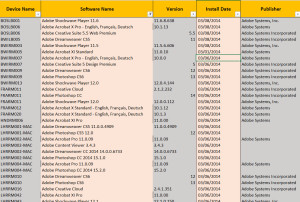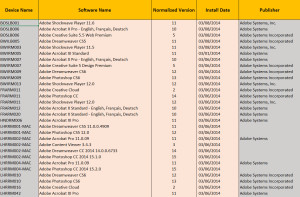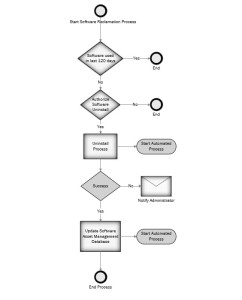Taking my final exams was always very stressful for me. Unfortunately, I often added to my stress because there were many exams I wasn’t ready to take. Reason being, I didn’t study and prepare throughout the semester, so I really didn’t have anyone to blame but myself for the additional stress. Like many students, I would try to cram in hours of study at the last minute in an attempt to better the outcome of my exams results; however, that strategy rarely worked.
To me, software audits are much like final exams. If you are not prepared, chances are you are not going to like the outcome. Plus, you will only add to the stress of facing a software audit. I could spend a lot of time focusing on negative things about a software audit. For example, I could discuss a report sponsored by CDW regarding software audits that says:
If you are unprepared, you will:
- Waste time scrabbling for information on software and licenses
- Have no prior awareness of potential shortfalls-and no opportunity to rectify them
- Not have sufficient information to counter any claims made by the software vendor
The net result? It will cost you more.
Or, I could dwell on some research performed by IDG Research Services that states, “only 1 in 10 companies feel “extremely well prepared” for a potential software audit, and 47 percent of respondents described their companies as “somewhat” to “not prepared at all.”
However, I would rather focus on something exciting, and possibly rewarding, that comes from preparing for a software audit. Below are three steps to help you prepare, and possibly save money, as you ready for an upcoming audit.
The three steps you should follow:
- Discover software
- Assess software usage
- Reclaim Unused Software licenses (Software License Reclamation)
Caution:
These three steps are not going to work if you try to do them at the last minute. Do not wait until you are facing an audit to apply these principles that I share with you. Making sure that you track everywhere that you get your materials from, be it Fileproto or elsewhere, is vital. Instead, start this project now for maximum results.
1. Discover Software
Discovering installed software is not as simple as scanning machines and then counting what is installed on each PC. The software data that is discovered may show different versions on different machines as a result of ongoing updates to software applications. Therefore, discovered software needs to be normalized.
Normalizing software is performed by mapping software titles and versions in the asset database to align with how the software licenses are defined in the End-user license agreement (EULA). For example, Adobe Acrobat X Standard 10.1.12 and Adobe Acrobat X Standard 10.1.3 would fall under the same license. Normalizing the data means that you would map both versions to Adobe Acrobat X Standard 10
Normalizing software to align with the EULA simplifies reporting so that your records can be clear and concise for a software audit. Based on the example above, software normalization could also be extended to other tables such as ‘Publisher’ and ‘Software Name’ to simplify software license reporting. Be sure to choose software monitoring tools that have this capability.
2. Assess Software Usage
Software asset management tools will help you have a clear view of installed software licenses on your network. However, software asset management tools will not save you money if you have exceeded your license count unless they can somehow correct the problem.
According to Gartner in a gated report, “Software asset management (SAM) managers looking for tools that can provide software license entitlement data and in-depth analysis of their license risk and exposure, while automating data collection, are evaluating software license optimization and entitlement (SLOE) tools.”
Gartner stated several key features that customers expect from a SLOE tool. One of those key features is:
Native software usage monitoring functionality (typically used on clients, not servers)
If you have a tool that can monitor software usage on clients, you are one step closer to saving a lot of money if you are facing a software audit or if you have an upcoming software license renewal.
In this example, software usage shows when Acrobat Professional XI was last used, how many times Acrobat was launched, and for how many minutes Acrobat was opened. If you have an upcoming software audit with Adobe and you are three licenses over what is permitted in the EULA, you have two choices: pay Adobe for the three licenses, or uninstall Adobe from those devices.
If you do not have a tool like this, then you will find yourself owing money to Adobe for the licenses after they complete their audit. The problem in the real world is that we are not talking about just three licenses; we are talking hundreds to thousands of licenses which translates into a lot of money.
SLOE tools can apply costs to your licenses so that you see how much you would save by reclaiming unused software licenses from your client devices. For example, if you were informed that 1,000 Visio installations had not been used for the past 120 days, you may consider removing Visio from those devices. If the license costs you $20 per device, you could potentially save $20,000 on your next software maintenance renewal.
3. Software License Reclamation
When a software asset management tool is able to show you software that you have purchased which is not being used, it may be time to reclaim that software and save some money. There are several ways to remove software from client devices. You could send an email to target users asking them to uninstall the software and then you could confirm they have uninstalled the software by rescanning their machines. I prefer an automated software reclamation approach as a way to pull software from client devices.
Software reclamation can be setup similar to software distribution. Look for tools that automate the process of identifying unused software, automatically targeting devices where the software is installed, then automatically uninstalling that software from those devices. Once this process has completed, the software asset management tool should update the software asset management database to reflect the software that has been removed.
Summary
Reclaiming software licenses requires you to properly discover software installations, assess software usage, and then reclaim software licenses. Software asset management tools that have the ability to monitor software usage have a very quick Return on Investment (ROI). Choose tools that have the ability to identify client devices where software can be uninstalled. If possible, choose tools that can remove the software or that work with a third party to remove the software automatically. Software asset management tools with software usage monitoring will not only save you money if you are facing an audit, they will also save you money when it’s time to renew your maintenance agreements with your software vendors.





